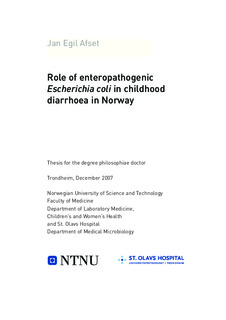| dc.contributor.author | Afset, Jan Egil | nb_NO |
| dc.date.accessioned | 2014-12-19T14:19:18Z | |
| dc.date.available | 2014-12-19T14:19:18Z | |
| dc.date.created | 2008-03-10 | nb_NO |
| dc.date.issued | 2007 | nb_NO |
| dc.identifier | 123790 | nb_NO |
| dc.identifier.isbn | 978-82-471-5823-4 | nb_NO |
| dc.identifier.uri | http://hdl.handle.net/11250/263733 | |
| dc.description.abstract | Background
Diarrhoeal diseases are among the leading causes of illness and death among children in developing countries, and do also cause considerable morbidity in industrialized countries. Enteropathogenic E. coli (EPEC), characterized by its ability to induce “attaching and effacing” (A/E) lesions the intestinal epithelium, is recognized as an important diarrheagenic agent in developing countries. Recently, EPEC has also been reported to be prevalent in the industrialized part of the world. Two main classes of EPEC have been recognized: typical EPEC has the ability to adhere to epithelial cells in discrete microcolonies, named “localized adherence” (LA). This trait is encoded by genes on a plasmid, called the EPEC adherence factor (EAF). Atypical EPEC does not contain the EAF and is not able to produce LA.
Aims
The aim of the study was to investigate the prevalence of EPEC and its epidemiological association with childhood diarrhoea in Norway. We also wanted to characterize the EPEC strains identified in the study by phenotypic and genotypic methods, and to search for bacterial factors statistically linked with diarrhoeal disease.
Materials and methods
The study was conducted in the County of Sør-Trøndelag, Norway. The prevalence of EPEC was first investigated in a retrospective laboratory based study of the aetiology of diarrhoea in children less than two years of age. Next a case-control study was carried out in children less than five years old. Cases were recruited as in the previous study, and healthy controls were recruited through Maternal and Child Health Centres. EPEC was identified by PCR, and the bacterial strains were characterized by DNA microarray, multilocus sequence typing, pulsedfieldgel electrophoresis (PFGE) and serotyping.
Results
EPEC was the most frequently identified enteropathogenic agent in the retrospective study, and was isolated from 38 (15.1%) of 251 children less than five years of age with diarrhoea in the case-control study. Strains of the EPEC pathotype were also common in healthy children where they were isolated from 21 (10%) of 210 subjects. There was no overall statistical association between EPEC and diarrhoea (P=0.3). EPEC strains were rarely diagnosed in children with severe diarrhoea, and were less common in children less than 12 months of age.
The majority of strains, 56/58 strains in the case-control study, were classified as atypical EPEC. The atypical EPEC strains showed extensive heterogeneity in sequence types and PFGE profiles. The strains were separated in three clusters based on all the virulence genes identified: one large cluster included all phylogenetic group A, B1 and D strains, and two smaller clusters consisted exclusively of phylogenetic group B2 strains. There was also considerable variation in serotypes, and almost half the strains were O serogroup non-typable.
Among a total of 95 putative virulence genes detected, seven genes were positively statistically associated with diarrhoea. Among these, the strongest statistical association was observed for the pathogenicity island OI-122 gene efa1/lifA (P=0.0002). The phylogenetic marker gene yjaA was strongly negatively associated with diarrhoea (P=0 0004).
The atypical EPEC strains could be classified in two virulence groups based on their content of virulence genes positively and negatively associated with diarrhoea. Strains belonging to the group which was not associated with diarrhoeal disease should probably be considered as colonizers which do not cause disease. The frequent isolation of such strains may be due to their apparent propensity for protracted colonization. Strains belonging to the other virulence group, which was significantly associated with diarrhoea, were isolated both from patients with acute and protracted disease.
Conclusions
EPEC was frequently isolated from Norwegian children both with and without diarrhoea, but was rarely associated with severe diarrhoea. The majority of EPEC strains were characterized as atypical EPEC. Genetic characterization showed extensive heterogeneity among the atypical EPEC strains in the study. Several virulence genes were positively and negatively statistically associated with diarrhoea, and the strains could be classified in two virulence groups based on their content of these genes: one group was not associated with diarrhoea, but appeared to be associated with protracted colonization. The other group was associated with both acute and protracted diarrhoea. | nb_NO |
| dc.language | eng | nb_NO |
| dc.publisher | Det medisinske fakultet | nb_NO |
| dc.relation.ispartofseries | Doktoravhandlinger ved NTNU, 1503-8181; 2007:260 | nb_NO |
| dc.relation.haspart | Afset, Jan E.; Bergh, Kåre; Bevanger, Lars. High prevalence of atypical enteropathogenic Escherichia coli (EPEC) in Norwegian children with diarrhoea. J. Med Microbiol. 52: 1015-1019, 2003. | nb_NO |
| dc.relation.haspart | Afset, Jan E.; Bevanger, Lars; Romundstad, P; Bergh, Kåre. Association of atypical enteropathogenic Escherichia coli (EPEC) with prolonged diarrhoea. J Med Microbiol. 53: 1137-1144, 2004. | nb_NO |
| dc.relation.haspart | Afset, Jan E.; Bruant, Guillaume; Brousseau, Roland; Harel, Josée; Anderssen, Endre; Bevanger, Lars; Bergh, Kåre. Identification of Virulence Genes Linked with Diarrhea Due to Atypical Enteropathogenic Escherichia coli by DNA Microarray Analysis and PCR. Journal of Clinical Microbiology. 44(10): 3703-3711, 2006. | nb_NO |
| dc.title | Role of enteropathogenic Escherichia coli in childhood diarrhoea in Norway | nb_NO |
| dc.type | Doctoral thesis | nb_NO |
| dc.contributor.department | Norges teknisk-naturvitenskapelige universitet, Det medisinske fakultet, Institutt for laboratoriemedisin, barne- og kvinnesykdommer | nb_NO |
| dc.description.degree | PhD i molekylærmedisin | nb_NO |
